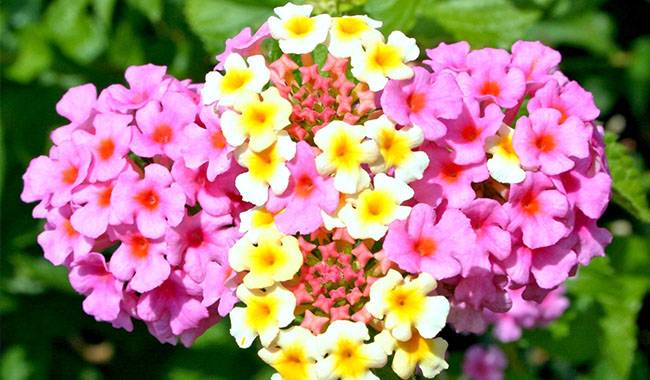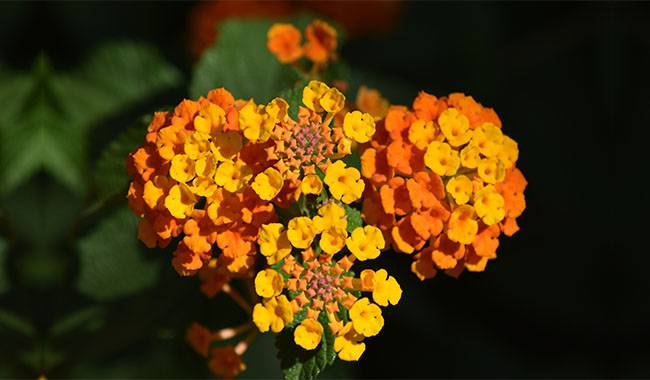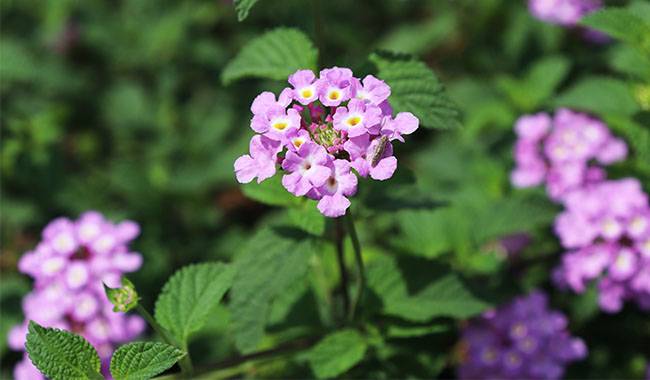
Not many indoor shrubs are better known for their flowering than for their beautiful shots. lantana camara is one of them. lantana camara is a strikingly easy-to-change growth form that is not surprising for its plainness, but for the beauty of its extraordinary inflorescences. The soft color transitions give the dense shield a rainbow effect. And it is difficult to take your eyes off the blooming, feminine, bright and so multi-colored Lantana Camara. But to enjoy its flowers, you’ll have to control overwintering conditions and watering frequency. But it grows very fast and recovers within a few weeks. You will learn How to Care for and Grow Lantana Camara Plant in the ThumbGarden article.
LANTANA CAMARA – A PLANT WITH “DOCILE” BRANCHES
Lantana Camara (West Indian Lantana) is a name that not all flower growers know. One of the most amazing herbaceous shrubs, it has earned a number of original nicknames – Spiky Nettle, Maiden’s Tongue, Spiky Colored Nettle, Rainbow Bush. The derogatory term “nettle” doesn’t exactly fit this gorgeous plant. If there is one thing Lantana Camara can bring to the table, it is its braggadocio.
The botanical name Lantana Camara probably comes from the ancient Roman “cranberry” and its inflorescences do slightly resemble the shield of a cranberry inflorescence, although they have more in common with other members of the verbena family.
Lantana Camara is the best known and most common species of the genus. Today, the species name is often not mentioned in sales, but if the plant is sold under the generic name “Camara”, it refers to balsam fir.
Depending on the planting and shaping strategy, Lantana Camara can be compact shrubs, spreading mats, neat trees, or less spreading trees, but they are still fast-growing plants with upright, dense branches that have strong, densely-branched roots that become woody.
Lantana Camara grows rapidly and is one of the most active non-frost-resistant crops. The quadrangular shoots are slow to lignify and the branches are surprisingly dense. The stronger the cut, the better the growth of young shoots. The plant develops rapidly, and even with strong pruning at the end of February, it can produce its first buds as early as April.
The shoots are usually thorny and the leaves are not densely packed, with leaves arranged in opposite directions, but without long internodes due to branching.
The leaves of Lantana Camara look a bit like nettles, but with a more solid appearance. The wrinkled surface, prominent veins, and oval leaf shape with elongated tips combine with coarse or fine teeth and sometimes a serrated margin. The leaves on the shoots are arranged on rather long petioles. The lustreless surface of the leaves looks velvety, partly because of the unusual pubescence along the veins, which is intensified on the back of the leaves.
On contact or rubbing, the leaves of Camelina give off a rather pungent scent that combines a spicy, refreshing, and unpleasant taste.
LANTANA CAMARA FLOWERING
Lantana Camara blooms relentlessly throughout the summer. The inflorescences seem to open behind each other, creating a continuous processional effect. the first buds appear on the plant at the end of April. the flowering of Lantana Camara usually lasts throughout September, although it does fade somewhat.
From up close, the inflorescences of Lantana Camara are spherical, simple hemispherical dense cushions, but from a distance, they look like perfect balls. Before flowering, the inflorescence is flat and disk-shaped, quickly changing to a simple flat whorl when the bushy tubular flowers appear on long pedicels. The maximum diameter of the inflorescence of Camelia Sinensis is about 2 inches (5 cm).
The ability to change color sets this plant apart from all other competitors. Of course, the “mechanism” for recoloring on Lantana Camara inflorescences is very simple: as it ages, the flowers become darker and richer in color. There are three different color variations on an inflorescence. The effect is striking.
Close in the spectrum, but often different in character, the lighter and brighter shades seem to watercolor into brighter shades in the already blooming flowers. And the plant appears iridescent: bright, primitive, multicolored.
The flowers open first at the edge of the inflorescence, so the color tones outside are always more intense. Only at the end of the flowering period, a few days after the last central flower opens does Lantana Camara finally take on a monochromatic color. But take a closer look at the flowers: inside each flower, subtle flecks of other shades still remind you of the rainbow miracle of watercolor painting.
The inflorescence of Lantana Camara is a typical yellow-orange-red. However, the development of varieties with brighter shades and almost monochromatic variations has brought the dull basic form out of sight. Even today, ornamental forms of plants cultivated in the 19th century are still very popular – white to yellow, pink and purple mutants, Common dogwood with inflorescences changing from yellow to red.
Like the classic Lantana mixta, whose “double” inflorescence consists of yellow cherry flowers on the outside and yellow-orange flowers on the inside, there are also white-blue Nivea and yellow-orange Crocea varieties.
More modern varieties have very large inflorescences. The brilliant orange russet “Cocktail”, the yellow-white “Golden Cloud” and the yellow-orange-pink “Pink Queen” are typical multi-flowered hybrids. Among the single-flowered varieties, the dazzling Lucky Lemon Frost is a particularly popular variety.
Not all Lantana Camara produces large quantities of fruit, but the basic plant and ornamental forms, as well as some of the older varieties, are sown in large quantities. The berry-like fruits are very poisonous until they ripen.
OTHER TYPES OF INDOOR LANTANA CAMARA PLANTS
The genus Lantana includes more than a hundred species of plants that are both shrubs and perennial herbs. In nature, you can enjoy the beauty of the sprawling, stunningly abundant Lantana Camara in the tropical regions of America and Africa, Australia, and Oceania.
The aggressiveness of Lantana Camara can sometimes be compared to that of weeds and causes many difficulties. The rainforests of Brazil are considered ideal for them, and attempts are made to recreate similar conditions in both greenhouses and rooms. Lantana Camara has been cultivated as a greenhouse and house plant since the 18th century.
There are dozens of Lantana Camara species that can be cultivated in pots. Although Lantana Camara remains the most popular variety, two other varieties are occasionally found on the market.
Lantana montevidensis, formerly known as Lantana Zello (Lantana sellowiana) is one of the most original Lantana species, and its structure is difficult to even estimate, as the adult plant’s canopy looks like a solid and dense pillow.
It is a Manzanita or semi-Manzanita with long, drooping shoots, planted in hanging baskets and used to create spectacular large waterfalls indoors. There are quite a few interesting varieties of this Lantana Camara, often named after the hue of the flowers: for example, the white-purple violet with its distinctive small bicolor inflorescence.
Lantana hybrida is a controversial compact variety of Camellia that does not exceed 40 inches (1 meter) in height even without pruning and is limited to 12 inches (30 cm) if it is a cultivar. It develops into a very low and dense cushion-shaped bush with yellow flowers only.
GROWING CONDITIONS FOR INDOOR LANTANA CAMARA

At first glance, the Lantana Camara appears to be a capricious, outlandish, and very striking outlier. But its characteristics do not quite match its colorful appearance. It is one of the least demanding plants, blooms beautifully, and is easy to find a comfortable place in the house.
The main thing is to try to create a difference between hot summers and cool winters and to provide enough light, without which Lantana Camara will not bloom.
Lighting and placement
Lantana Camara is a light-loving plant. They do well in full sun and bright windowsills and are not afraid of direct sunlight, but they still grow better in diffused light. In winter, very strong light must be maintained, but only for cool and non-leafing Lantana Camara.
Stand-alone or in groups by any window, except the north window. Plants should be rotated regularly to allow for even canopy development.
Temperature control and ventilation
Exposure to fresh air is very important for Lantana Camara. Even indoor Lantana Camara is best brought outside in summer and placed on the terrace, in the garden, or at least on the balcony.
In June, after the threat of the year-old cold has disappeared, put the Lantana Camara out and bring them back before the first frost. In the garden, Lantana Camara prefers a sunny spot. If placed in a room, ventilate the plant daily or place Lantana Camara in a place where windows are frequently opened.
Lantana Camara tolerates both high temperatures and normal room temperatures during active growth. A cool overwintering period is a prerequisite for flowering. Houseplants prefer to overwinter at temperatures of about 50 °F (10 °C) – possibly as low as 46 °F (8 °C) and as high as 53 °F (12 °C).
Only in this temperature regime can Lantana Camara retain its leaves and recover quickly. Lantana Camara can also withstand a warm over winter, but then its leaves are completely shed and need to be placed in an almost dry substrate, in the dark, and thoroughly pruned after overwintering.
CARING FOR LANTANA CAMARA PLANTS AT HOME

This unique herb is not difficult to care for at all, but the care routine must be regular. Standard watering, feeding, and other care items combined with a mandatory sanitation program are all the plant needs.
Watering and air humidity
The main objective of caring for Lantana Camara is not to allow the substrate to dry out completely. This plant does not tolerate humidity, but if it is not watered and the ground is allowed to dry out, Lantana Camara will start to shed its lower leaves.
Water the plant and let the upper part of the substrate dry out, but be careful to maintain a steady humidity level. The plant is not afraid of heavy watering, but it is best to drain the tray 20-30 minutes after watering.
During the overwintering period, water Lantana Camara a few times and try to keep the soil very lightly moist. If plants are overwintered in cooler temperatures, water very carefully. If the leaves fall off in warm conditions, water only to keep the roots alive. The water should be soft and warm.
Lantana Camara can be sprayed outside of the flowering period, but they also tolerate dry air very well. However, keeping the leaves clean and gently dusting them off is a must.
Fertilizer and fertilizer ingredients
Although Lantana Camara grows vigorously and consumes soil fairly quickly, it does not tolerate over-fertilization. Even if you use standard garden potting or flowering plant strategies, there is a risk of over-fertilizing and encouraging leaf growth to the detriment of flowering.
For Lantana Camara, fertilize regularly from March to the end of the flowering season, usually every 2 weeks, but reduce the fertilizer concentration by a factor of 2 compared to the manufacturer’s instructions. Regular but infrequent fertilization is undesirable because it will cause fluctuations in soil nutrient levels and make the growing environment unstable.
Although Lantana Camara is a flowering crop, it is not suitable for fertilizers specifically designed to stimulate flowering. This crop prefers a balanced fertilizer with equal amounts of the three macronutrients. Potassium phosphate fertilizer should only be applied when the budding stage is ready for flowering.
Pruning and shaping Lantana Camara
Lantana camara blooms only on annual shoots that have not yet begun to lignify, and regular pruning will only encourage more flowers.
This is a unique plant that should be pruned at least 2-3 times regularly during the summer to promote tillering and flowering. For Lantana Camara, prune in late winter or before transplanting, repeating conditioning cuttings or slightly shortening shoots up to 4-5 times per season.
For all Lantana Camara varieties, it is crucial to perform shaping in the first two years – when the plant is given the shape of a tree and a shrub, which is maintained only from the third year onwards. It is possible to shorten the shoots of Lantana Camara to the desired profile or size, leaving at least 1-2 pairs of leaves on the branches. Strong pruning and light pruning are both equally well tolerated by Lantana Camara.
If Lantana Camara overwinters in warm conditions or begins to lose its ornamental qualities and needs to be rejuvenated, prune drastically, leaving only the lower buds on the branches and pruning off lignified branches where old ones are severely elongated. Such Lantana Camara needs to be repotted.
Lantana Camara, despite its vigorous flowering and seemingly difficult growth, is one of the best candidates for room furnishings. The plant’s crown can be carefully and gently pruned to a specific shape, most often – emphasizing the natural density and spherical contours.
The neat and ornate bolts on the stem can be a small wonder in a container. Cutting back a tight canopy is especially common for Lantana Camara which is grown as an indoor or garden plant and overwintered indoors.
Lantana Camara can be grown as a dwarf planet and is surprisingly easy to form. To turn Rainbow Nettle into a tree, simply leave the central shoot untouched until it grows to a height of 24 inches (60 cm) or more, removing only all lateral branches and leaving the base of the shoot bare to a height of 12-20 inches (30-50 cm). Beyond 20 inches (50 cm), the main stem of Lantana Camara should not be pushed out, as the long stem will not keep the plant stable.
Transplants, containers, and substrates
Lantana Camara grows very fast and occupies the available soil just as quickly. The rapid development of above-ground parts and rhizomes requires regular repotting. Although like other buttercups, Lantana Camara is best transplanted as needed, transplanting is usually done annually. Only plants in a neglected state or forming strict stems have time to assimilate all the substrate within a year.
Often, insufficient space for root development and soil depletion will cause Lantana Camara to stop flowering. Without transplanting, it is still necessary for the plant to replace the topsoil with a fresh, nutritious substrate.
Always choose large, spacious, deep containers with good drainage holes for Lantana Camara.
A loose and nutritious soil mix is preferred, but not one that is too rich. Lantana Camara consumes any substrate fairly quickly, but too much fertility can interfere with flowering and encourage vigorous growth, but choose a medium or low nutrient substrate that will both better accommodate the plant and promote flowering.
Simple soil mixtures consisting of equal parts leaf soil and sand or substrates consisting of sod, leaf soil, peat, and sod soil-based sand are suitable for Lantana Camara. If using purchased substrates, mix them with complex ingredients and be sure to add an extra portion of the loosening agent.
Transplanting is usually done with a shortened root system after the container has reached its maximum capacity. A high drainage layer should be placed at the bottom of the container.
Pests and problems in Lantana Camara planting
When partially grown outdoors and neglected, Lantana Camara can suffer from rust, spotted disease, and non-specific wilt. Any disease on the plant should be treated immediately with a systemic fungicide. If the roots have rotted, Lantana Camara can only be saved by emergency replanting.
Pests that are not uncommon in this unique beauty include whiteflies, spider mites, and aphids. The best way to deal with insects is to start an insecticide treatment immediately.
Any preventive and curative measures for Lantana camara should be combined with moving the plant to a quarantine area, correcting conditions and care, pruning severely damaged parts, and keeping the leaves spot-free and clean.
Propagation of Lantana Camara
This is not the easiest way to propagate plants. the best way to propagate Lantana Camara is called cuttings: young, healthy, strong green shoots will root well in a consistently moist substrate or in water with frequent water changes and, if correctly shaped, will quickly produce lush, beautiful shrubs.
Cuttings of Lantana Camara can be taken throughout the peak growth period, from spring to fall, and regular pruning can provide plenty of rooting material.
If semi-woody cuttings are used, the root only in the substrate, under the hood, and are always cut off with heel cuttings. The main secret of taking cuttings of any Lantana Camara, including Lantana Camara, is the freshness of the cuttings. The cuttings should be placed in water or soil as early as possible to prevent them from drying out and the leaves from losing tension and wilting.
Rooting is not affected by growth stimulants; it is the “freshness” of the cuttings that is decisive, not their treatment. After rooting, the plants can be propagated into their own containers.
Lantana Camara can be grown from seed or, if the variety is flowering and fruiting, from freshly harvested seed. Pre-treatment includes soaking or steaming in hot water and exposure to rooting stimulants. Plant immediately after harvest in winter with extra light, or at the end of February. Lantana Camara is sown in the same way as traditional annuals – in light soil, under glass or aluminum foil, on a lightly moistened substrate.







